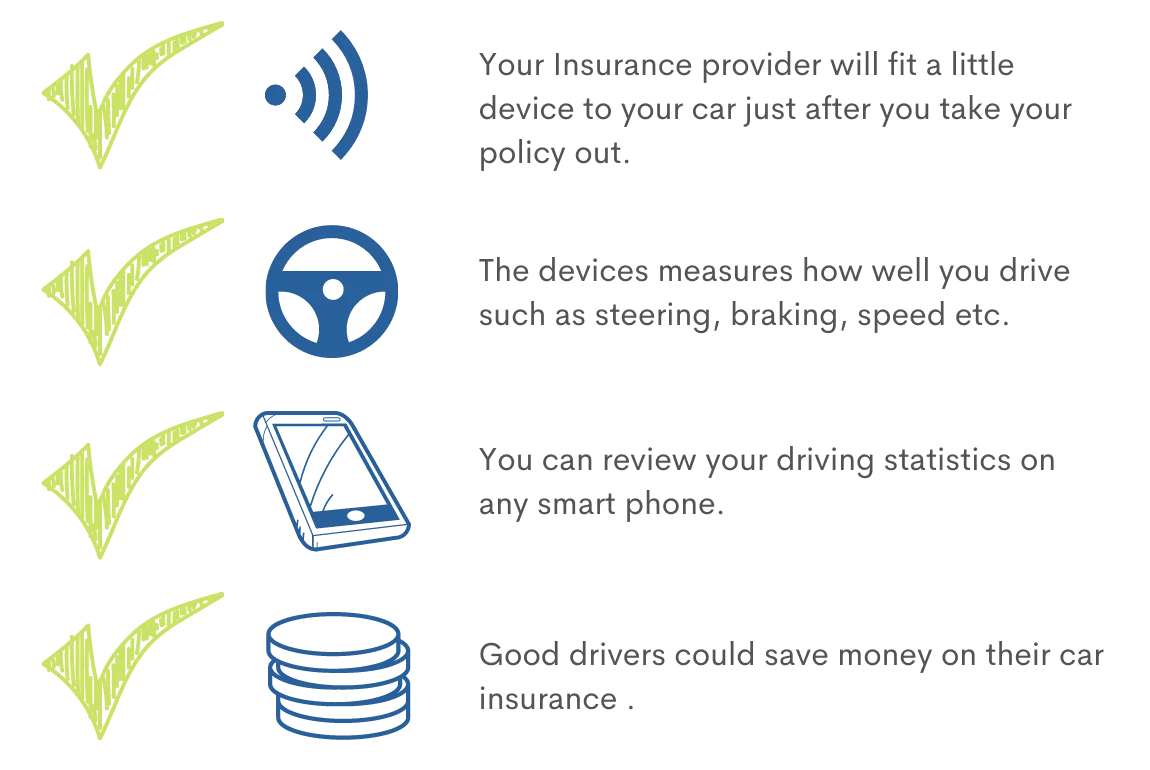Black Box Car Insurance for Young Drivers
Compare quotes for black box car insurance for young drivers aged 17 to 24 from the leading UK insurers and find the best telematics car insurance quotes for you.
Many new and young drivers accept a few minor restrictions of a black box for the benefits of cheaper insurance, the opportunity to earn extra discounts and of safe driving.
Black box insurance for young drivers can be significantly cheaper than insurance cover without a black box but still gives you all the benefits of standard comprehensive cover.
As a young driver, you’ll know that the price of car insurance does not favour the young. However, there is some good news! After twelve months of claim-free driving, you qualify for a no-claims discount with significantly lower insurance premiums by as much as 50%.
Black Box Insurance Quotes
Black box car insurance quotes have become a cornerstone for young drivers seeking fair pricing on their car insurance.
Not only does a black box insurance quote for young drivers offer premiums based on actual driving data instead of general statistics. But when you explore car insurance quotes with black box further, it becomes clear that this type of insurance serves as a motivator for cultivating safer driving habits.
How does black box insurance work?
Once installed, your insurer will monitor your driving habits and use this data to adjust your premiums! A small device called a black box with a GPS tracker is fitted inside your car, by the insurer, which actively feeds back information to enable the insurer to see how safely you’re driving! The insurance company then uses this information about how you drive to give you an overall driving score.
So, if you are a good driver, you could expect to see lower car insurance premiums. However, drive like a maniac, and you could face a higher premium.
Black box insurance for young drivers has all the benefits of cover without a black box cover. Including fully comprehensive cover, no-claims discount for each accident free year of driving, motor legal protection.

How car insurance works through Autedia
Are telematics car insurance and black box insurance the same thing?
When people discuss telematics car insurance and black box insurance, they usually refer to the same thing. In reality, black box car insurance is just one of several types of telematics technology.
What is the black box driving score?
Your insurer calculates your driving score, typically monthly, using the data from your car’s black box. Driving safely gets a higher score, while an erratic driving style scores fewer points.
Safe drivers are a significantly lower risk and insurers will reward better drivers with extra discounts, such as monthly bonus miles or money back on your insurance policy, some insurers even offer shopping vouchers as a reward.
Once your policy starts be careful with who you might allow to drive your car. The black box measures how your vehicle is driven, not who the driver is. So, your driving score could take a hammering if you allow the wrong driver behind the wheel.
How is your driving score calculated?
The black box typically monitors your journeys and driving skills including speed, acceleration, braking, cornering and usually your phone usage.
Scores are usually calculated in the range of 1 to 100, with 100 indicating the best driver style.
What is considered a good driving score? A driving score of 70 plus will mean that with most insurers, you are a safe driver and less likely to have an accident and less likely you’ll have your insurance cancelled due to a low score.
What are the key indicators on black box insurance driving scores?
The speed you drive – The GPS Tracker in your car’s black box can determine what speed you should be travelling. Instances of excessive or persistent speeding will negatively affect your driving score, meaning the insurer may need to cancel your policy. After all, your black box car insurance is only cheaper if you drive safely.
How you break – If you brake harshly, it can indicate several things about your driving. For example, stopping your vehicle harshly could mean travelling too close to the car in front to react safely to changing traffic conditions.
Acceleration – Accelerating too quickly can indicate the risk you represent on the road. Gentle acceleration and using the gears smoothly means safer control of your car.
Cornering – The telematic device (black box) has some technology that monitors the G force your car creates when cornering, allowing the insurer to check if you’re taking corners at the correct speed.
Mobile phone use – These telematic devices can detect when you’re using your mobile phone, even when it’s “hands-free”.
Other factors that can impact your driving score include
Your driving performance is primarily weighted on the riskier indicators of speed, acceleration, braking and cornering. However, the following are also taken into account when calculating your score:
Time of day – Very few black box car insurance policies have a curfew. However, there is usually a negative adjustment to your score if you frequently drive late at night typically between the hours of 11pm and 5am you are more likely to be tired and have more risk of an accident.
The type and speed limit of roads you drive on – This indicator determines if you frequently drive on urban or rural roads. Statistically you are more likely to have an accident in urban areas, that is why the speed limits are lower.
How can I view my Driver Score?
Your black box insurance provider will have an app for Apple and Android smartphones and you can have access to an online dashboard to view your driving score and performance.
When you log into the dashboard you can see your score for how you drive each journey, a map shows you your routes and you can see your overall driving score. You’ll be able to analyse your driving stats and your strengths and weaknesses. You’ll even be able to see any excessive speeding, when how you accelerate or braking events. Working on your weak points can improve your driving skills and lower your insurance premiums!
The app also shows if you have aced your drive and made a smooth journey with no faults. However don’t worry to much about the odd mistake because your performance score is calculated as an average across each journey, so breaking heavily won’t damage your score as long as you don’t make it a habit.
How is the black box installed?
The black box device, about the size of a mobile, is usually fitted in or near the dashboard . It’s not something you do yourself. though. When you sign up for the insurance policy, your insurer will arrange for the fitting of the black box into your car which is usually at a garage. It’s worth noting here you need to have the following documents handy before installation:
- Your driving licence or documents to show you’ve passed your test
- Your car’s logbook (V5C) to prove you own the vehicle. If you are still waiting for the V5C, you’ll need some other document to show you own the car
If your black box links to an app , you can download this to your smartphone for it to start working.
Black box insurance myths
There are likely some exclusions on black box policies (as with all insurance policies), but don’t fall for the myths – it’s not that restrictive. For instance, you probably won’t be penalised for:
Night driving: Don’t worry; you can still drive when you want. Very few black box policies have a curfew on driving late at night. However, you are more likely to be in an accident when it’s dark outside.
Long/frequent drives: You aren’t restricted to journeys to Asda and back. You’re not limited to how much you can drive, but again, you may see a higher premium if you log high mileage.
Check mileage limits: It’s rare but not unheard of, some black box and telematic policies might impose a mileage limit – make sure this is realistic before you sign on the dotted line.
Shift workers: You must find the right black box policy if you’re a shift worker. Investigate the fine print and ensure you won’t get heavily penalised for driving at night. There’s no harm in picking up the phone from a prospective insurance company.

The telematics box can detect an accident and find a stolen vehicle
In addition to monitoring how you drive, the black box has security and safety features.
Accident alert – the black box in your car can detect a strong impact on the vehicle, such as in an accident. In the event of a collision the insurer will likely be able to contact you to check you are OK and get any necessary emergency services.
Car theft tracker – Many of these telematic boxes come with an anti-theft tracker, enabling the insurer to give the Police your vehicle’s location data to help find your car if it is stolen.
Is black box car insurance a cheaper insurance than standard?
It’s hard to say – black box insurance quotes, and all car insurance in general, are individual dependent. Your situation and personal details will determine your costs.
However, telematics insurance is a great way to save a significant chunk on your insurance costs if you’re a new or young and inexperienced driver.
Black box insurance is best suited to young drivers, such as 17 to 19-year-olds as they could struggle to get a realistic quote for standard insurance cover. As you get older, it becomes easier to get insurance without a black box policy.
Remember, black box insurance serves a purpose – it’s a cheaper way to get yourself on the road. There are some restrictions, but they’re minor. Plus, it won’t be forever – in a few years, regular insurance rates won’t be as astronomical as they are now!
Black box car insurance for 17 year olds
At Autedia, we provide black box car insurance for 17-year-olds. Standard car insurance does not consider the safe driving of many young drivers. However, suppose you get 17-year-old car insurance with a black box. You can demonstrate your safe driving skills and obtain cheaper black box insurance through good driving habits as a young person.
How can black box insurance benefit young drivers?
Black box insurance is often more favourable for young drivers than standard insurance. In some cases, young drivers may not be able to get traditional insurance for many different reasons, leaving telematics insurance as their only available choice.
Typically, more than half of young drivers under 20 take out black box cover there is a sold reason for this, insurers see this age group as the highest risk.
Of course, some young drivers aren’t happy about the prospect of a black box – it can feel like someone is always watching you drive, and it seems to take away from your freedom.
However, you have nothing to worry about if you’re a safe driver! You’ll be fine if you’re not regularly speeding, putting your foot completely down to accelerate, and emergency braking every time you reach a traffic light.
By taking out telematics car insurance, you could achieve lower insurance premiums than with standard (no black box insurance).
According to data from Money Supermarket, a considerable proportion of younger customers take out a black box insurance policy:
- 54% of drivers between the ages of 17 and 19 take out black box insurance
- 13% of drivers between the ages of 20 and 24 take out black box insurance.
- 5% of drivers between the ages of 25 and 29 take out black box insurance.
As you can see, black box insurance is designed for the youngest and most inexperienced drivers.
If you’re getting on the road, lowering your insurance premium can be an excellent option. You won’t need it forever!
How to get cheaper telematics insurance?
TWO things you can do to help yourself get cheaper car insurance.
Understand how to best answer the car insurance questions BEFORE you fill in your car insurance application.
Use a comparison website like Autedia to compare black box insurance for young drivers – Autedia offer black box insurance by comparing quotes from the leading black box insurers helping you find the cheapest telematics car insurance.
Are there different kinds of telematics insurance devices?
Yep! There are a few types of telematics devices available
Black box
The black box is the most widely used type of telematics cover. Your insurer will arrange for a third party to install a black box in your car, which uses GPS to track your driving. ‘Black box’ might give off the impression of a large, invasive device, but it’s the size of a mobile. You won’t even notice it’s there.
Plug-and-drive
Like black box, plug-and-drive devices also use GPS technology, but rather than installing a black box; your insurer will send you a device that plugs into your car’s charging port or cigarette lighter. You don’t need a third party to install it.
Smartphone App
Nowadays, some insurers offer an app you can install on your smartphone that tracks your driving similarly without installing a separate device in your car.
Do I have to pay the insurer to fit the black box in my car?

You won’t have to pay anything extra for installation as the price of fitting the box is in your premium.
Your insurance company will arrange to fit the box in your car, usually at home or in a local garage.
FAQs - Black box car insurance
However, if broken, some rules could cost you much more, such as losing your insurance policy. Tampering with the telematics box or consistently driving over the speed limit will likely result in the insurer cancelling your insurance.
When you get a black box car insurance policy, you’ll often choose the mileage allowance you require, around 6,000, 8,000, and 10,000-mile policy cover. The more miles driven, the higher your premium. Plan with your mile because it’s cheaper than exceeding your mileage cap and having the cost of buying extra miles.
You could save up to £504*
*51% of consumers could save £504.25 on their Car Insurance. The saving was calculated by comparing the cheapest price found with the average of the next five cheapest prices quoted by insurance providers on Seopa Ltd’s insurance comparison website. This is based on representative cost savings from September 2023 data. The savings you could achieve are dependent on your individual circumstances and how you selected your current insurance supplier.




